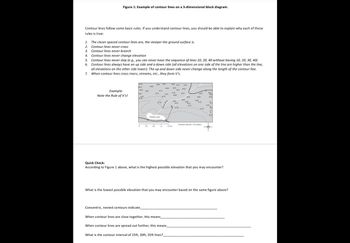Quick Check: According to Figure 1 above, what is the highest possible elevation that you may encounter?
Quick Check: According to Figure 1 above, what is the highest possible elevation that you may encounter?
Applications and Investigations in Earth Science (9th Edition)
9th Edition
ISBN:9780134746241
Author:Edward J. Tarbuck, Frederick K. Lutgens, Dennis G. Tasa
Publisher:Edward J. Tarbuck, Frederick K. Lutgens, Dennis G. Tasa
Chapter1: The Study Of Minerals
Section: Chapter Questions
Problem 1LR
Related questions
Question

Transcribed Image Text:Contour Lines: Contour lines indicate the shape of the land surface, i.e. its topography. A contour line is the map trace of
an imaginary line on the ground that has a particular elevation. One way of visualizing such a line is to imagine a
shoreline. Bodies of standing water have level upper surfaces, thus their shorelines are traces on the ground surface of
that particular elevation. Topographic maps have many contour lines, each adjacent line differing by a constant
elevation difference, the contour interval (Figure 1).
CONTOUR
INTERVAL
100
80
Example:
Note the Rule of V's!
Figure 1: Example of contour lines on a 3-dimensional block diagram.
53
-57
Contour lines follow some basic rules. If you understand contour lines, you should be able to explain why each of these
rules is true:
1. The closer spaced contour lines are, the steeper the ground surface is.
2. Contour lines never cross
6
80
3. Contour lines never branch
4. Contour lines never change elevation
5. Contour lines never skip (e.g., you can never have the sequence of lines 10, 20, 40 without having 10, 20, 30, 40)
6. Contour lines always have an up side and a down side (all elevations on one side of the line are higher than the line,
all elevations on the other side lower). The up and down side never change along the length of the contour line.
7. When contour lines cross rivers, streams, etc....they form V's.
64
67
-76
75
Concentric, nested contours indicate
<.05
100
04
.60
58.
08
*74
Pebble Lake
75
78
00
78
68
75
deve
12 1.6 km
56
When contour lines are close together, this means,
When contour lines are spread out further, this means
What the contour interval of 25ft, 30ft, 35ft lines?
B
63
70
68
.60
illl
57 +52
61
70
79
53
40
*57
£=
.60
55
.68
75
-53
.60
CONTOUR LING
72
78
Contour interval-10 moters
W
56
60
63
Quick Check:
According to Figure 1 above, what is the highest possible elevation that you may encounter?
6
What is the lowest possible elevation that you may encounter based on the same figure above?
Expert Solution
This question has been solved!
Explore an expertly crafted, step-by-step solution for a thorough understanding of key concepts.
This is a popular solution!
Trending now
This is a popular solution!
Step by step
Solved in 4 steps

Follow-up Questions
Read through expert solutions to related follow-up questions below.
Follow-up Question
Question 2

Transcribed Image Text:Figure 1: Example of contour lines on a 3-dimensional block diagram.
Contour lines follow some basic rules. If you understand contour lines, you should be able to explain why each of these
rules is true:
1. The closer spaced contour lines are, the steeper the ground surface is.
2. Contour lines never cross
3.
Contour lines never branch
4.
Contour lines never change elevation
5.
Contour lines never skip (e.g., you can never have the sequence of lines 10, 20, 40 without having 10, 20, 30, 40)
6. Contour lines always have an up side and a down side (all elevations on one side of the line are higher than the line,
all elevations on the other side lower). The up and down side never change along the length of the contour line.
7. When contour lines cross rivers, streams, etc... they form V's.
Example:
Note the Rule of V's!
53
.64
67
-65
.60
Concentric, nested contours indicate_
Pebble Lake
100-
*74
DB
12
60
<- 68
75
What is the contour interval of 25ft, 30ft, 35ft lines?
ya
When contour lines are close together, this means
When contour lines are spread out further, this means
B
1.6km
58
70
-60
-57
.61
68
-70
52
53
57
55
68
75
-53
60
Contour interval-10 meters
50-
Quick Check:
According to Figure 1 above, what is the highest possible elevation that you may encounter?
56.
What is the lowest possible elevation that you may encounter based on the same figure above?
60-
63
Solution
Recommended textbooks for you

Applications and Investigations in Earth Science …
Earth Science
ISBN:
9780134746241
Author:
Edward J. Tarbuck, Frederick K. Lutgens, Dennis G. Tasa
Publisher:
PEARSON

Exercises for Weather & Climate (9th Edition)
Earth Science
ISBN:
9780134041360
Author:
Greg Carbone
Publisher:
PEARSON

Environmental Science
Earth Science
ISBN:
9781260153125
Author:
William P Cunningham Prof., Mary Ann Cunningham Professor
Publisher:
McGraw-Hill Education

Applications and Investigations in Earth Science …
Earth Science
ISBN:
9780134746241
Author:
Edward J. Tarbuck, Frederick K. Lutgens, Dennis G. Tasa
Publisher:
PEARSON

Exercises for Weather & Climate (9th Edition)
Earth Science
ISBN:
9780134041360
Author:
Greg Carbone
Publisher:
PEARSON

Environmental Science
Earth Science
ISBN:
9781260153125
Author:
William P Cunningham Prof., Mary Ann Cunningham Professor
Publisher:
McGraw-Hill Education

Earth Science (15th Edition)
Earth Science
ISBN:
9780134543536
Author:
Edward J. Tarbuck, Frederick K. Lutgens, Dennis G. Tasa
Publisher:
PEARSON

Environmental Science (MindTap Course List)
Earth Science
ISBN:
9781337569613
Author:
G. Tyler Miller, Scott Spoolman
Publisher:
Cengage Learning

Physical Geology
Earth Science
ISBN:
9781259916823
Author:
Plummer, Charles C., CARLSON, Diane H., Hammersley, Lisa
Publisher:
Mcgraw-hill Education,